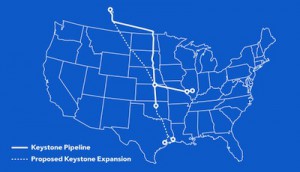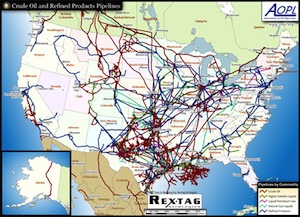Vast network of pipelines already in place in U.S.
Daily News Article — Posted on February 2, 2012
(by Cristina Corbin, FoxNews.com) – While the Obama administration says it needs more time to assess the potential risks surrounding the proposed Keystone XL pipeline, a vast underground network of more than 2 million miles of energy pipeline already traverses the United States.
Several energy experts who represent the oil and gas industry say the controversial Keystone XL, a 1,700-mile pipeline that would run from Canada to Texas, poses less of a risk to the environment than the estimated 50,000 miles of crude oil pipelines already crisscrossing the U.S., a network they say is safe and efficient.
The Obama administration on [January 18th] blocked a permit for the $7 billion Keystone XL, at least temporarily, claiming a more thorough review is needed to examine problems it may pose to the nation’s air and water quality. The administration also blamed Republicans for including a provision in a recent tax cut bill that compelled a decision within a 60-day time frame.

The solid line is the current existing Keystone 1 pipeline; the dotted line is the proposed Keystone XL pipeline.
The pipeline system, proposed by the Canadian firm TransCanada, would transport crude oil from the Athabasca Oil Sands in northeastern Alberta [Canada] to multiple locations in the U.S., including as far as the Gulf Coast of Texas. The Keystone XL would go through Montana, South Dakota, Nebraska, Kansas and Oklahoma, and the so-called “feeder pipelines” would connect it to rich oil fields in North Dakota and Montana.
The U.S. State Department has expressed concerns over the pipeline’s environmental impact, particularly in the Nebraska Sandhills, an area of porous hills that includes a high concentration of wetlands and a key aquifer.
Environmental activist groups claim the pipeline system could pollute air and water supplies as well as harm fragile ecosystems. The original route also called for the pipeline to cross the Ogallala Aquifer, one of the world’s largest aquifers that extends into eight states and provides drinking water for two million people.
“It will be environmentally and economically devastating if there were to be a spill,” Kim Huynh, a spokeswoman for Friends of the Earth, told FoxNews.com. “We think that Keystone XL pipeline would be dirty at both ends and certainly dangerous in between.” She described tar sands oil as “the world’s dirtiest oil” that she said “needs to stay in the ground.” Huynh also said the air surrounding oil refinery communities adds “immense amount of air pollution that causes lung disease and other detrimental health impacts.”
But several energy experts say the Keystone XL would be no different from an extensive network of energy pipelines already in place – and some say its state-of-the-art design would make it safer than many of the country’s aging pipelines.
“There’s no shortage of energy pipelines,” Dan Kish, senior vice president for policy at the Institute for Energy Research, told FoxNews.com. “This pipeline would be better than 1.9 million miles of pipeline already in the United States. It’s newer and has the best technology.”
Maps of the U.S. energy pipeline system show a vast abundance of crude oil pipelines crossing through states like Montana to Minnesota to Texas. [NOTE: Map on left too small to read which types of pipelines each color represents; this is to give you a general understanding of where most of our pipelines are located. For a detailed map, click here and scroll down.]
Major oil pipelines include a 9,467-mile network operated by Magellan Pipeline Co. LLC; a 7,833-mile system owned by MidAmerican Energy Company; and 7,646 miles of pipeline owned by Plains All-American Pipeline LP. Other top oil pipeline companies include ConocoPhillips with 6,027 miles and Colonial Pipelines with 5,596 miles.
Kish said underground pipelines are the safest way to transport crude oil, though he acknowledged that “whenever you have any kind of human endeavor, you have potential problems and they do occur.”
“We have tens of thousands of pipeline and I don’t think there’s any good evidence that pipelines are a significant impact on ecosystems to the point that they can’t adapt,” said Kenneth Green, resident scholar at the American Enterprise Institute.
Kish and Green said the alternative to pipeline systems is to transport the oil by tanker, train or truck – all of which they said pose a considerably higher risk for accident and spillage and cost far more in the long run.
“Do we tell Canada to move the oil to Texas by truck?” Green asked.
Robert Schulz, a professor at the University of Calgary’s Haskayne School of Business, said a common “misperception” held by many environmental activists is that oil from Canada is “dirtier” than crude that comes from other parts of the world.
But, Schulz argued, the contaminants in Canadian oil — – particularly CO 2 – are reasonably similar to those coming from oil sources in Venezuela and the Middle East.
“Eighty-four percent of the environment’s contaminants come from a car tail pipe — not from producers. So if they [activists] really had a problem, they wouldn’t drive their cars,” added Schulz.
TransCanada has promised to reapply for a presidential permit after finding a route through Nebraska that would circumvent sensitive areas.
Nebraska Gov. Dave Heineman, a Republican, and other state lawmakers had expressed concern over Keystone’s original route because of its close proximity to the state’s water supply. But Heineman told Fox News on Thursday that he’s confident an alternative route being worked out with TransCanada will not pose a risk to environmentally sensitive areas and should certainly meet federal approval.
“I fully expect we could get it done, certainly in the early September, August timeframe,” Heineman told Fox News. “I would send the letter back to the president of the United States saying we approve it and if he were decisive, he could turn around and approve it shortly thereafter, well before the November election.”
FoxNews.com’s Cristina Corbin and the Associated Press contributed to this report.
(NOTE: This article was originally published at FoxNews.com on Jan. 21st.)
Reprinted here for educational purposes only. May not be reproduced on other websites without permission from Fox News. Visit the website at FoxNews.com.
Questions
1. a) How many miles of crude oil pipelines currently crisscross the U.S.?
b) What is the Keystone XL pipeline? Be specific.
2. Why did the Obama administration block the permit TransCanada needs to build the pipeline?
3. a) What individuals/groups are opposed to the Keystone pipeline? Why?
b) How does the environmental group Friends of the Earth want the oil to be transported?
4. How do energy experts defend the construction of Keystone, and refute environmentalists' objections? Be specific.
5. What is TransCanada doing to address the Obama administration's concerns about the route of the Keystone XL pipeline?
6. Read the information under "Background" below the questions, and visit the website links under "Resources." Consider this information, as well as the maps found in the article. Your answers to these questions will help you decide which candidates you would vote for in state, local and national elections. Find the candidate who takes the same stand on the issue that you do. (It is necessary to consider all of the major issues of the day, and which side of the issues the candidates support. Vote for the candidate who agrees with you on the issues that are the most important to you.)
a) Were you aware of the extent of the fuel pipelines that cross the U.S.?
b) What do you think about assurances that the new Keystone pipeline will be safe? Explain your answer.
c) Which is more important: protecting the environment from any possibility of an oil spill, or creating jobs and providing abundant, affordable fuel? Explain your answer.
d) Do you think Americans should support construction of the Keystone XL pipeline? Explain your answer.
e) Discuss your answers to #6 with a parent. How do your answers compare?
Background
From an InstituteforEnergyResearch.org post on 9/29/11:
- Three years ago [in 2008], TransCanada proposed the $7 billion Keystone XL pipeline to bring more oil from Canada to the United States. After years of study, the State Department has yet to decide whether or not approve the pipeline. The Keystone XL should be a no-brainer—more jobs and greater access to oil from our closest ally.
- Because the pipeline crosses the border from Canada, the State Department must decide whether the pipeline is in the “national interest.” This should be a simple question. Is it in the “national interest” to get oil from Canada, our largest trading partner and most reliable ally, or should we import more oil from more hostile countries? Even without considering the economic arguments, it should be that simple.
- The economic arguments for the pipeline are also persuasive. The construction of the pipeline alone will create 20,000 jobs. States along the route are projected to receive an additional $5.2 billion in property tax revenue.
From a Bloomberg News editorial posted 9/26/11:
- In deciding whether to allow Keystone XL to run through six American states, the only relevant question is whether it would be safe. The State Department, with help from the Environmental Protection Agency, has studied the risks. It has determined that, as long as TransCanada complies with all laws and regulations, builds Keystone XL properly and operates it safely (although some minor spills would be expected), the pipeline would have “no significant impacts” on wetlands, water supplies or wildlife along its route.
- Keep in mind, the U.S. is crisscrossed by thousands of miles of pipelines carrying crude oil, liquid petroleum and natural gas. One of these is the Keystone 1 pipeline, which already carries crude from the oil sands. Yes, these pipes sometimes leak -- spectacularly last year when almost 850,000 gallons of oil spilled from a ruptured pipe in Michigan. Far more often, when leaks occur, they are small and self-contained.
- Pipeline opponents have implied that if the U.S. doesn’t buy Canada’s oil, then companies will be discouraged from developing the oil sands. But it’s unrealistic to assume that the oil couldn’t be sold elsewhere. Yes, today’s business plan calls for sending most of it south -- some 700,000 barrels a day through Keystone XL. If the U.S. blocks that conduit, though, we can reasonably expect that another pipeline would be built to Canada’s west coast, where the oil could be sent by tanker to China and elsewhere.

